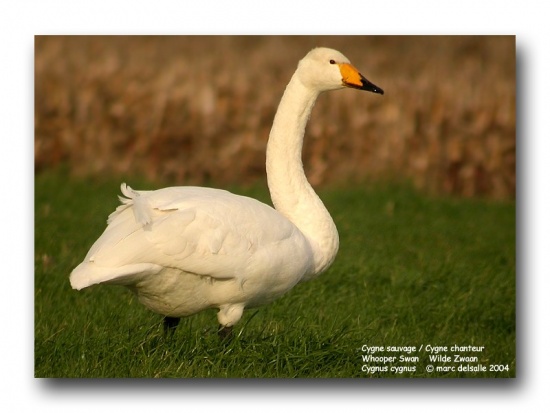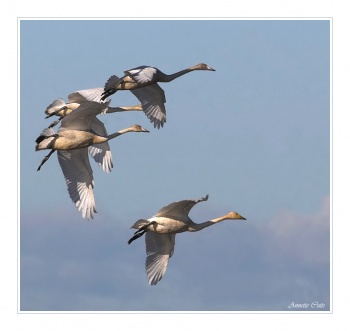(→References: Updated and expanded) |
(Photo captions, copyright and dates.) |
||
| Line 1: | Line 1: | ||
| − | [[Image:Whooper_Swan.jpg|thumb|550px|right|Photo by {{user|Marc+Delsalle|Marc Delsalle}}<br /> | + | [[Image:Whooper_Swan.jpg|thumb|550px|right|Adult<br />Photo © by {{user|Marc+Delsalle|Marc Delsalle}}<br />Merkem, [[Belgium]], 29 January 2004]] |
;[[:Category:Cygnus|Cygnus]] cygnus | ;[[:Category:Cygnus|Cygnus]] cygnus | ||
==Identification== | ==Identification== | ||
| Line 11: | Line 11: | ||
====Similar Species==== | ====Similar Species==== | ||
[[Mute Swan]] has a red bill, a longer, acutely pointed tail, and usually a more curved neck; juvenile Mutes also differ in darker brown admixed with some white feathers by winter. In [[Bewick's Swan]] the yellow on the beak has a rounded apex. [[Trumpeter Swan]] lacks the yellow on the bill, but is otherwise very similar, though the two species do not normally overlap in the wild. | [[Mute Swan]] has a red bill, a longer, acutely pointed tail, and usually a more curved neck; juvenile Mutes also differ in darker brown admixed with some white feathers by winter. In [[Bewick's Swan]] the yellow on the beak has a rounded apex. [[Trumpeter Swan]] lacks the yellow on the bill, but is otherwise very similar, though the two species do not normally overlap in the wild. | ||
| − | [[Image:IMG 02565.jpg|thumb|350px|right|Photo by {{user|Macswede|Macswede}}<br />Ågesta, near Stockholm, [[Sweden]], October 2010]] | + | [[Image:IMG 02565.jpg|thumb|350px|right|Adult in flight<br />Photo © by {{user|Macswede|Macswede}}<br />Ågesta, near Stockholm, [[Sweden]], 10 October 2010]] |
==Distribution== | ==Distribution== | ||
Breeds in [[Iceland]], in small numbers in coastal north [[Norway]], in north-central and sparsely in south-central [[Sweden]], north and east [[Finland]] and across Arctic [[Russia]]. In recent decades has begun to breed in [[Poland]] and [[Scotland]], and an occasional breeder in [[Estonia]], [[Latvia]], and [[Belarus]]. The small numbers breeding in Scotland (and occasionally [[Northern Ireland]]) may originally have involved injured birds that have been prevented from migrating, but the recent population growth in the far north (10-15 pairs, mainly in [[Shetland]]) is more likely fuelled by immigration from the increasing Icelandic population. | Breeds in [[Iceland]], in small numbers in coastal north [[Norway]], in north-central and sparsely in south-central [[Sweden]], north and east [[Finland]] and across Arctic [[Russia]]. In recent decades has begun to breed in [[Poland]] and [[Scotland]], and an occasional breeder in [[Estonia]], [[Latvia]], and [[Belarus]]. The small numbers breeding in Scotland (and occasionally [[Northern Ireland]]) may originally have involved injured birds that have been prevented from migrating, but the recent population growth in the far north (10-15 pairs, mainly in [[Shetland]]) is more likely fuelled by immigration from the increasing Icelandic population. | ||
Icelandic birds are only partially migratory with some birds wintering, particularly in the west. The remainder winter in Britain and Ireland. There is no significant evidence for any wintering in south and east [[England]] from the Continental breeding populations, which winter from coastal north Norway to the [[Baltic States|Baltic]] and west to northeast [[France]], in parts of Central Europe and around the eastern Mediterranean, Black and Caspian Seas. Leave breeding grounds mid September-October and begin return movement in March-April, arriving in May. | Icelandic birds are only partially migratory with some birds wintering, particularly in the west. The remainder winter in Britain and Ireland. There is no significant evidence for any wintering in south and east [[England]] from the Continental breeding populations, which winter from coastal north Norway to the [[Baltic States|Baltic]] and west to northeast [[France]], in parts of Central Europe and around the eastern Mediterranean, Black and Caspian Seas. Leave breeding grounds mid September-October and begin return movement in March-April, arriving in May. | ||
| − | [[Image:Whooperflybf.jpg|thumb|350px|right|Juveniles<br />Photo by {{user|psilo|psilo}}<br />[[Martin Mere]], [[Lancashire]], October 2010]] | + | [[Image:Whooperflybf.jpg|thumb|350px|right|Juveniles in flight<br />Photo © by {{user|psilo|psilo}}<br />[[Martin Mere]], [[Lancashire]], 20 October 2010]] |
====Vagrancy==== | ====Vagrancy==== | ||
Wanders widely in severe winters and can turn up almost anywhere in Europe. Vagrant north to [[Svalbard]] and south to [[Israel]] and north [[Africa]]; also some records in western [[North America]] (mainly [[Alaska]]), when may be found together with [[Trumpeter Swan]]s. | Wanders widely in severe winters and can turn up almost anywhere in Europe. Vagrant north to [[Svalbard]] and south to [[Israel]] and north [[Africa]]; also some records in western [[North America]] (mainly [[Alaska]]), when may be found together with [[Trumpeter Swan]]s. | ||
Revision as of 07:19, 24 September 2018
- Cygnus cygnus
Identification
Length 140-165 cm, wingspan 205-235 cm, weight 7.5-12.7 kg
- White body
- Long thin neck
- Tail short, wedge-shaped
- Black legs
- Black bill with large triangular yellow patch
- Juveniles uniform pale grey-brown, with dull pinkish on bill where adults have yellow
Similar Species
Mute Swan has a red bill, a longer, acutely pointed tail, and usually a more curved neck; juvenile Mutes also differ in darker brown admixed with some white feathers by winter. In Bewick's Swan the yellow on the beak has a rounded apex. Trumpeter Swan lacks the yellow on the bill, but is otherwise very similar, though the two species do not normally overlap in the wild.
Distribution
Breeds in Iceland, in small numbers in coastal north Norway, in north-central and sparsely in south-central Sweden, north and east Finland and across Arctic Russia. In recent decades has begun to breed in Poland and Scotland, and an occasional breeder in Estonia, Latvia, and Belarus. The small numbers breeding in Scotland (and occasionally Northern Ireland) may originally have involved injured birds that have been prevented from migrating, but the recent population growth in the far north (10-15 pairs, mainly in Shetland) is more likely fuelled by immigration from the increasing Icelandic population.
Icelandic birds are only partially migratory with some birds wintering, particularly in the west. The remainder winter in Britain and Ireland. There is no significant evidence for any wintering in south and east England from the Continental breeding populations, which winter from coastal north Norway to the Baltic and west to northeast France, in parts of Central Europe and around the eastern Mediterranean, Black and Caspian Seas. Leave breeding grounds mid September-October and begin return movement in March-April, arriving in May.
Vagrancy
Wanders widely in severe winters and can turn up almost anywhere in Europe. Vagrant north to Svalbard and south to Israel and north Africa; also some records in western North America (mainly Alaska), when may be found together with Trumpeter Swans.
Taxonomy
This is a monotypic species[1].
Habitat
Breeds on lakes and pools in forest or on tundra, sometimes in river deltas, estuaries and sheltered sea inlets. In winter found in coastal areas or lakes and large rivers, often grazing in fields.
Behaviour
Nesting
Both sexes build the nest. The clutch of 4-7 eggs is incubated by the female for about 36 days. The cygnets can fly at an age of 120 to 150 days.
Diet
The diet includes aquatic plants, grass, and grain.
Vocalisation
<flashmp3>Cygnus cygnus (song).mp3</flashmp3>
Listen in an external program
References
- Clements, J. F., T. S. Schulenberg, M. J. Iliff, D. Roberson, T. A. Fredericks, B. L. Sullivan, and C. L. Wood. 2018. The eBird/Clements checklist of birds of the world: v2018. Downloaded from http://www.birds.cornell.edu/clementschecklist/download/
- Carboneras, C. & Kirwan, G.M. (2018). Whooper Swan (Cygnus cygnus). In: del Hoyo, J., Elliott, A., Sargatal, J., Christie, D.A. & de Juana, E. (eds.). Handbook of the Birds of the World Alive. Lynx Edicions, Barcelona. (retrieved from https://www.hbw.com/node/52807 on 24 September 2018).
- Madge, S. & Burn, H. (1988) Waterfowl. An identification guide to the ducks, geese and swans of the world. Houghton Mufflin, Boston.
- Todd, F. (1979). Waterfowl. Ducks, Geese & Swans of the World. Sea World, San Diego.
- RSPB
Recommended Citation
- BirdForum Opus contributors. (2024) Whooper Swan. In: BirdForum, the forum for wild birds and birding. Retrieved 3 May 2024 from https://www.birdforum.net/opus/Whooper_Swan
External Links






